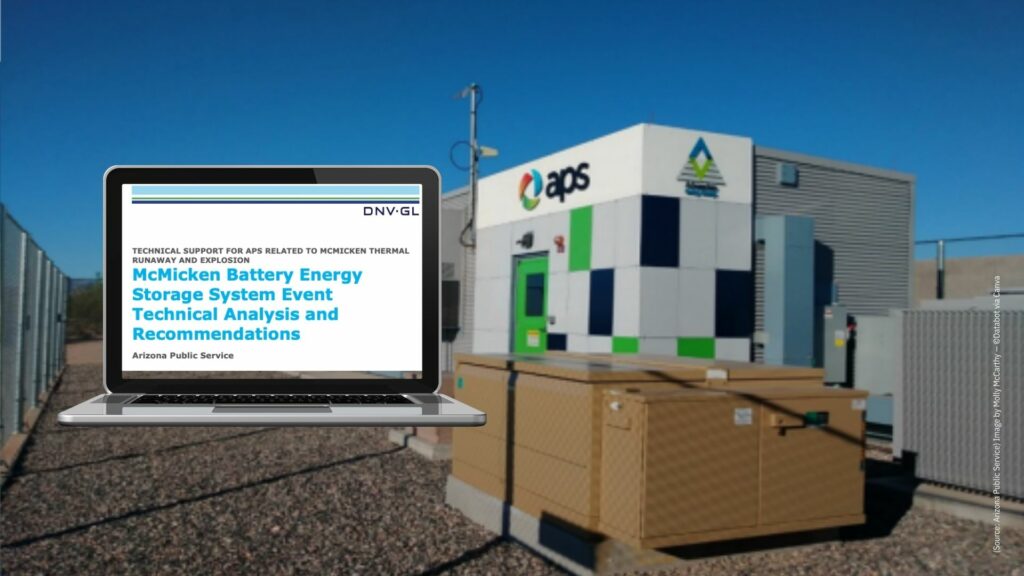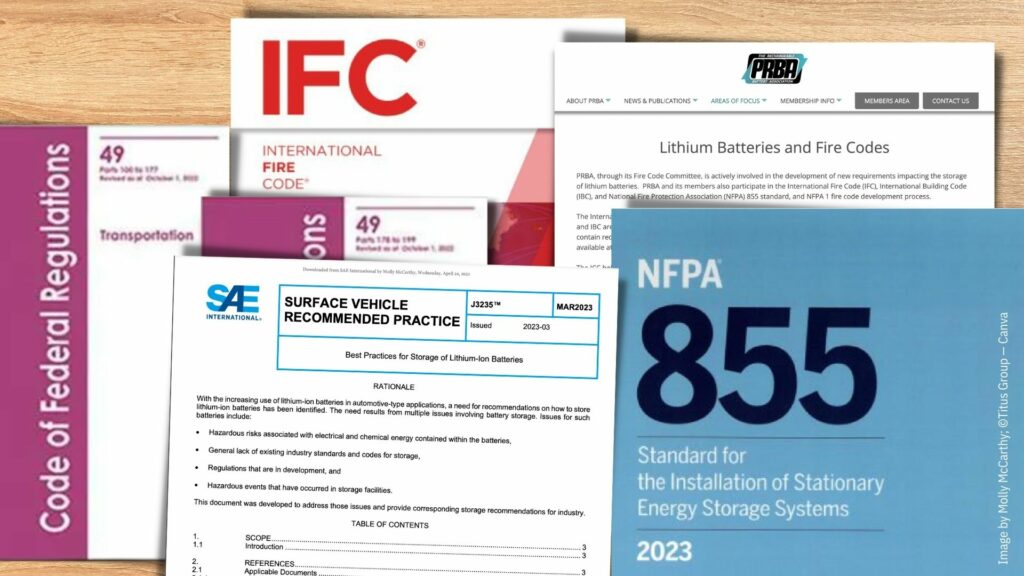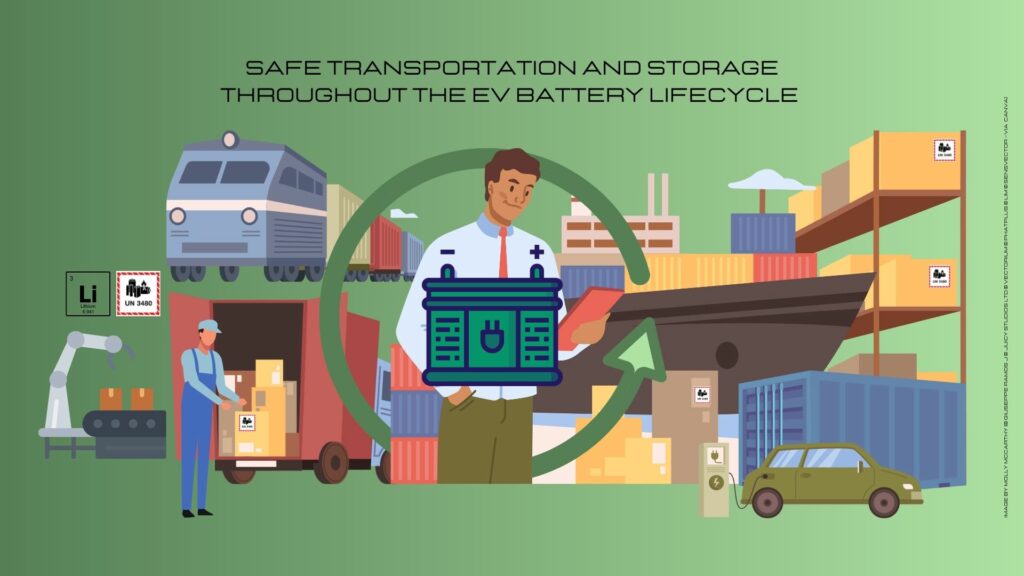Large-format, rechargeable lithium batteries, commonly known as large-format lithium-ion or Li-ion batteries, are essential for those developing electric vehicles. Should we be concerned about how Li-ion batteries are transported and stored en masse even when unplugged and considered inactive? Emerging standards, research, and best practices can serve as a framework for the safe transportation, storage, and handling of EV batteries throughout their lifecycle.
Thermal Runaway Events
When we think of large-format Li-ion batteries exploding and causing a fire, it makes sense that most of us think about electric vehicles in accidents. The basic physics of any large-format Li-ion battery used for an electric vehicle – whether comprised of cylindrical, prismatic, or pouch-type battery cells – is such that there’s a lot of energy potential in a relatively small space. In a car crash, the impact could initiate a chain reaction within the battery, causing a thermal runaway. Thermal runaways are uncontrollable self-heating states initiated at a rate faster than a battery can dissipate. Such events are often indicated by smoke, fire, or even explosions. Manufacturing defects in EV batteries can also cause thermal runaways with similar results.
In April 2019, a large-format Li-ion battery fire made the news when two experienced fire captains, Justin Lopez and Hunter Clare of the Peoria, Arizona, fire department answered a call at the McMicken BESS in Surprise, Arizona, 28 miles northwest of downtown Phoenix. The McMicken BESS facility, roughly the size of a shipping container, was configured similarly to a computer data center: 27 racks, each containing 14 battery modules, powered the grid.
According to news and incident reports, responders saw a white cloud of vapor seeping out of the building upon arrival. They tested the air and found dangerous hydrogen fluoride and carbon monoxide levels. They waited approximately three hours for the cloud to dissipate. Thinking the coast was clear, Lopez and Clare opened the door to the facility, which agitated the gasses inside and allowed them to contact a heat source or spark. Shortly after the door was opened, there was a large explosion inside the facility. Both men experienced life-altering injuries, including brain trauma. Two other firefighters were also severely injured. The energy system and container were destroyed.
Causes & Prevention
The Arizona Public Service (APS) report on the fire offered insight into what happened and lessons learned to prevent a similar tragedy in the future. The collaborative study, which included insight from key stakeholders, forensic experts, and a nationally recognized research institution, homed in on five key reasons the explosion occurred:
- An internal failure in a battery cell – in this case, a sudden drop in voltage during a charge cycle – initiated a thermal runaway.
- The fire suppression system was incapable of stopping the thermal runaway.
- Lack of thermal barriers between cells led to a cascading thermal runaway.
- Flammable off-gasses concentrated without a means to ventilate.
- The emergency response plan had no extinguishing, ventilation, or entry procedure.

Transport & Storage
Thermal runaway events are a concern when new, defective, or used Li-ion batteries are transported, stored, and handled at EV battery manufacturing plants, car dealerships, repair and recycling facilities, and auto dismantler sites.
In 2021, the EPA held a workshop and gathered input from relevant stakeholders in the Li-ion battery lifecycle. The group included device and electric vehicle manufacturers, large-format Li-ion battery manufacturers, collectors and recyclers, hazardous and municipal waste managers, insurance agents, and government officials. They evaluated scenarios where EV batteries are stored at recycling plants. “Fires resulting from thermal runaway can be devastating,” they wrote in the workshop’s executive summary. “These events have the potential to disrupt U.S. recycling infrastructure.”
“From 2012 to 2018, fire departments in the U.S. responded to an average of 200 fires per year involving Li-ion batteries, compared to an average of 50 fires per year from 2007 to 2011,” said David Bursell, Vice President of Business Development at MoviTHERM. His company offers thermography solutions for monitoring Li-ion battery activity, whether plugged in or not, when stored, transported, used in BESS systems, or in any environment where quantities are significant enough to create a risk.
As indicated by Bursell, Li-ion battery fire numbers have grown significantly. According to an NBC News report, in New York City alone, the fire department reported 200 Li-ion battery fires in 2022, injuring 147 people and killing six, double what they responded to in 2021. So far, in 2023, they have responded to over 30 fires believed to have been caused by Li-ion batteries.
Are Lithium-ion Batteries Ever Inactive?
All batteries contain electrical and chemical energy that pose a hazard even if discharged. Li-ion batteries present a unique safety hazard due to their high energy density and flammable electrolytes. Consequently, they are often discharged to less than 30 percent before transport, a state of charge (SoC) referenced as providing an additional level of safety. Li-ion batteries shipped by air are mandated to be at no more than 30 percent SoC. This SoC limit does not apply to other modes of transport like rail or sea.
While the risk of a thermal runaway exists with new batteries, it is significantly higher for defective batteries heading to or at facilities where they will be fixed, refurbished, or recycled. This increased risk is because these batteries may have undergone significant wear and tear or damage.
“Fixing, refurbishing, or recycling batteries can involve potentially hazardous operations such as disassembly, reassembly, and chemical treatment, further increasing the risk of thermal runaway incidents,” Bursell said. “Therefore, it is critical to ensure that appropriate safety measures are in place and followed when handling, transporting, and storing defective or used batteries.”
Thermal Runaway Risk Factors
Several factors, including battery age, remaining charge, and transportation or storage conditions, can influence thermal runaway risks. Essentially, thermal runaway concerns increase as EV batteries progress through their lifecycle. Minimizing risk requires careful consideration of all these factors.
In contrast to energy storage, the range of physical locations where large-format Li-ion batteries are stored can include car dealerships where up to several dozen batteries may be present or EV production facilities where thousands of batteries may be held. The range of battery transport options includes a van with just a few batteries in the back, a big rig with more, a train with hundreds across multiple containers, or a ship with thousands across numerous containers.
The rise in U.S.-based EV battery manufacturing plants, EV battery repair and recycling facilities, and auto dismantling sites equates to a growing concern about how large-format Li-ion batteries are stored and handled. “Thermal runaway events, where the battery overheats and catches fire, can pose significant liability risks for businesses and individuals,” Bursell said.

Guidelines & Provisions
The International Code Council (ICC) and the National Fire Protection Association (NFPA) are the two main organizations responsible for developing model codes and standards for building construction and fire safety. The ICC publishes the International Fire Code (IFC) and International Building Code (IBC).
The IFC and NFPA 855 standards are the de facto references for the storage requirements of portable and large-format Li-ion batteries. However, organizations like The Rechargeable Battery Association (PRBA) say the current edition of IFC (2021 IFC) in effect in most states and jurisdictions is lacking provisions on what is required when storing large quantities of portable, large-format Li-ion batteries. PRBA, established in 1991 and based in Washington, DC, advocates for their members in various regulatory, legislative, and standards forums at the state, federal, and international levels. IFC amendments that address EV battery handling for automotive and other applications are expected to find their way into Chapter Three of the IFC 2024 update (the IFC is updated on a three-year revision cycle).
“The 2024 edition of the IFC will have provisions on the indoor and outdoor storage of lithium-ion batteries, and several states and jurisdictions have already adopted these requirements,” said George Kerchner, PRBA Executive Director.
“Many provisions have been added to the 2024 International Fire Code,” said Beth Tubbs, Chief Fire Prevention Engineer at the International Code Council. “Additionally, the ICC Fire Code Action Committee realizes the urgency and need to continue to address lithium-ion batteries at various levels.”
Continued Work & Research
Tubbs explained how a working group is compiling proposals to be sent through the ICC Code Development Process in 2024 for the 2027 I-Codes (i.e., IBC and IFC). She said topics explored include storage and recycling, use with EVs (including charging), micro-mobility, and further refinement of the ESS requirements. “Experts from the fire service and industry are participating in and following these activities,” she added.
Meanwhile, the NFPA offers requirements for installing Li-ion battery energy storage systems in the 2023 edition of NFPA 855, the standard for the Installation of Stationary Energy Storage Systems. This standard, written expressly for energy applications, includes requirements in Chapter 14 for storing Li-ion and lithium metal batteries. The NFPA plans to incorporate additional precautions in their next update (NFPA standards are updated every three to five years).
“The NFPA technical committees for these standards are aware of the unique hazards that lithium-ion batteries present and the need for these documents to incorporate additional precautions,” said Brian O’Connor, Fire Protection Engineer at the NFPA.
O’Conner offered some examples, including the development of NFPA 855, Standard for the Installation of Stationary Energy Storage Systems; the considerations for electric vehicles in NFPA 13, Standard for the Installation of Sprinkler Systems; the NFPA 88A, Standard for Parking Structures; and the addition of a section on micro-mobility devices to the upcoming edition of NFPA 1, Fire Code, which he said is not yet finalized.
The NFPA noted that the Fire Protection Research Foundation (the research affiliate of NFPA) continues to research this area to support the development of NFPA codes and standards. The Foundation’s current projects include EV hazards in parking garages, BESS hazards and mitigation strategies, and stranded energy within lithium-ion batteries.
Code of Federal Regulations
U.S. Hazardous Materials Regulations (specifically 49 CFR 173.185) contain detailed testing, packaging, labeling, and employee training requirements for companies shipping or transporting large-format Li-ion batteries. These regulations are based on international regulations and standards established by the United Nations Sub-Committee of Experts on the Transport of Dangerous Goods.
“PRBA has played a major role in representing the industry on these transport regulations at the United Nations since the early 2000s,” Kerchner said. “The regulations for shipping and testing large-format Li-ion batteries are rather complex and often change and vary depending on the mode of transport being used, whether road, rail, air, or ocean.”

Automotive Industry Resources
Two automotive industry-specific resources, PRBA and SAE International, keep leaders informed by offering their members regular updates on the evolving standards, regulations, and best practices for safe storage, transportation, and handling of large-format Li-ion batteries.
For example, the PRBA Fire Code Committee kept its members updated early on in the process of the IFC amendments to provide early access to the IFC 2024 code. While the NFPA develops its standards independently, one of the organizations it relies on for ongoing research specific to automotive is SAE International. Aware of the unique challenges of safely transporting, storing, and handling EV batteries for all-manner of automotive applications, retired fire officer Ronald Butler, now CEO of Energy Storage Safety Products International (ESSPI), sponsored the latest SAE International research that offers guidance in this area.
“The problem we need to solve is not just making EV batteries; it’s also planning for the safe transportation and storage infrastructure to support the batteries throughout their lifecycle,” Butler said.
SAE J3235 Standard
According to the SAE International press release on SAE J3235, the authors offer insight into fire suppression and detection technologies to help educate the storage industry about the opportunities available to implement in their facilities. According to SAE International, the authors’ recommendations for creating a robust plan emphasize the need to “properly identify the battery type(s) to be stored and the storage location and the corresponding considerations for containment, fire detection and suppression, emissions management, and run-off controls.” SAE noted that nothing precludes other industries from using these recommendations.
“What keeps me, and many others, awake at night is not necessarily the threat of an EV fire in a garage, but rather the very real issues posed by failing batteries in the logistics lifecycle,” Butler said. “This issue poses a real threat to the forward movement of promising green technologies.”
Several events involving Li-ion batteries in storage have led to the proposed development of new fire codes. “These code changes aim to improve the safe storage of lithium-ion batteries but do not provide specific knowledge about the hazards and mitigations available for every situation,” Butler added.
ESSPI was funded by the United States Department of Transportation’s Pipeline and Hazardous Materials Safety Administration to research, identify, and develop the tools and technologies needed to control battery failure events during transport. “The expected outcome of these activities includes smarter, more effective ways to transport, store, and charge batteries,” Butler said. “These are the types of solutions that the industry requires right away.”
Additional Resources & Guidance
The good news is that federal agencies like the U.S. DOT and organizations like the ICC, NFPA, SAE International, and PRBA offer support and best practices for businesses that deal with EV battery transport and storage. For example, the U.S. DOT recently issued a guidance document on the safe transport of lithium-ion batteries and a Safety Advisory Notice on the transport of waste lithium-ion batteries that includes information on the packaging of damaged or defective batteries.
Another essential resource is your local Authority Having Jurisdiction (or AHJ for short). This person or collection of people, whether your local fire marshal, an insurance underwriter, or a building code professional, is responsible for enforcing ICC (IBC and IFC) codes and NFPA standards relevant to your site. For all of the above, your AHJ will be immensely helpful in guiding you in planning and implementing your safe storage solution specific to your needs. They will reference code language like that found in the NFPA 1 or IFC.
Additional relevant resources include publications from industry associations and research organizations such as the National Renewable Energy Laboratory, the Electric Power Research Institute, the Joint Research Centre of the European Commission, and consulting firms specializing in battery storage. Bursell explained that the codes, standards, and best practices from a multitude of organizations can work together to provide comprehensive guidance on large-format storage. “However, it is important for companies to ensure they comply with relevant regulations and standards, as well as seek advice from industry experts as needed,” he said.
As more EV batteries are manufactured in the U.S., and even more are coming out of cars for end-of-life triage, it is imperative that transport and storage systems are safe throughout the EV battery lifecycle. Safe and robust systems will help ensure a sustainable circular EV battery ecosystem by saving lives, preventing property destruction, and reducing air, soil, and water contamination.


